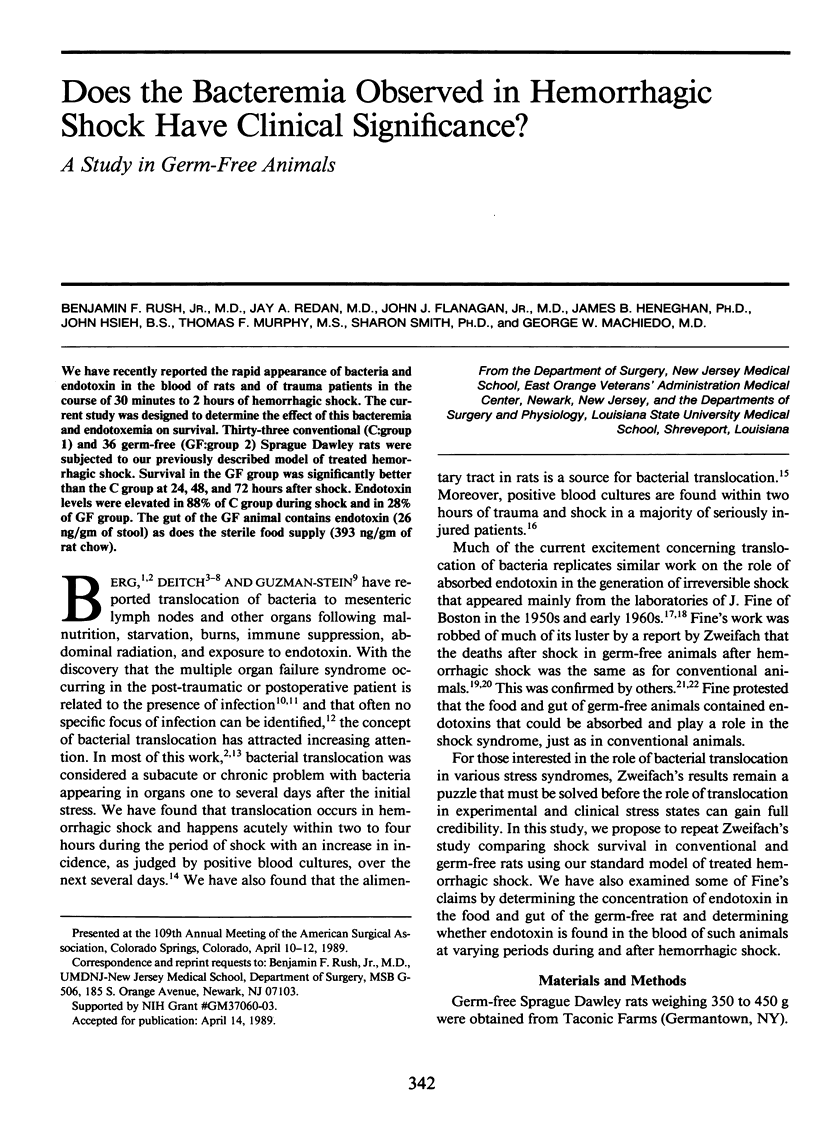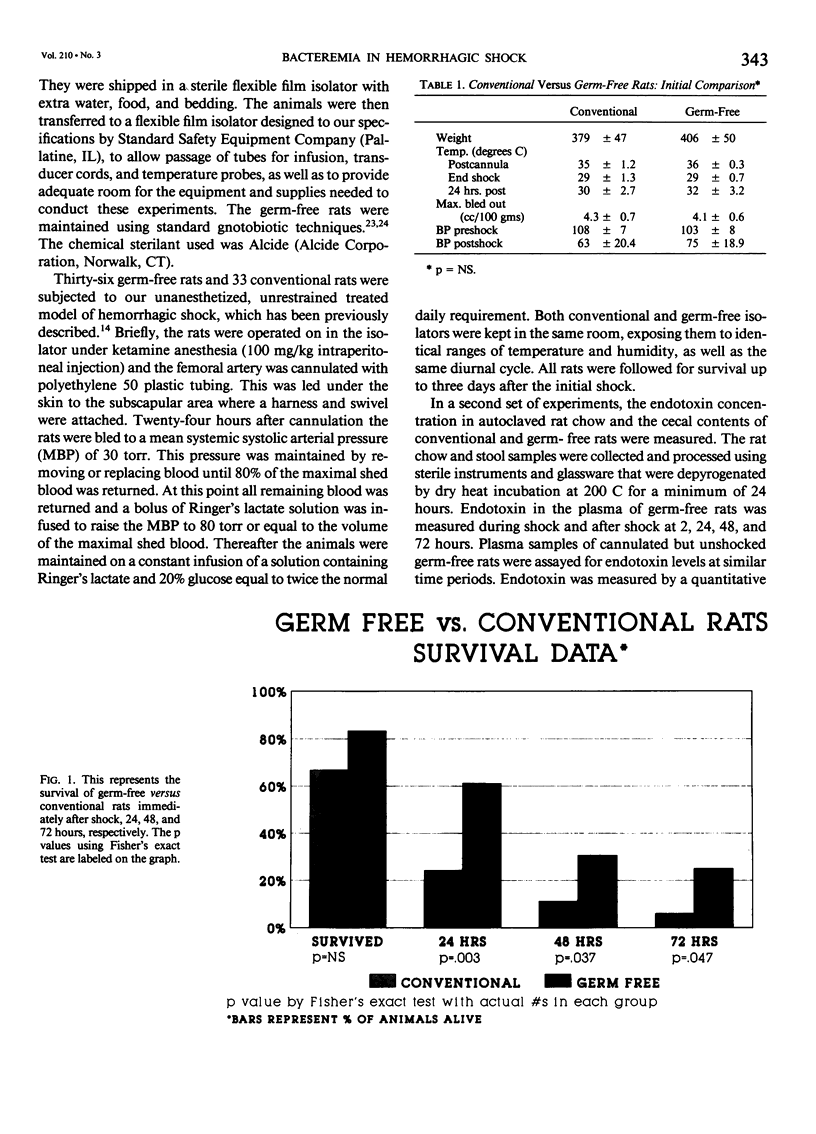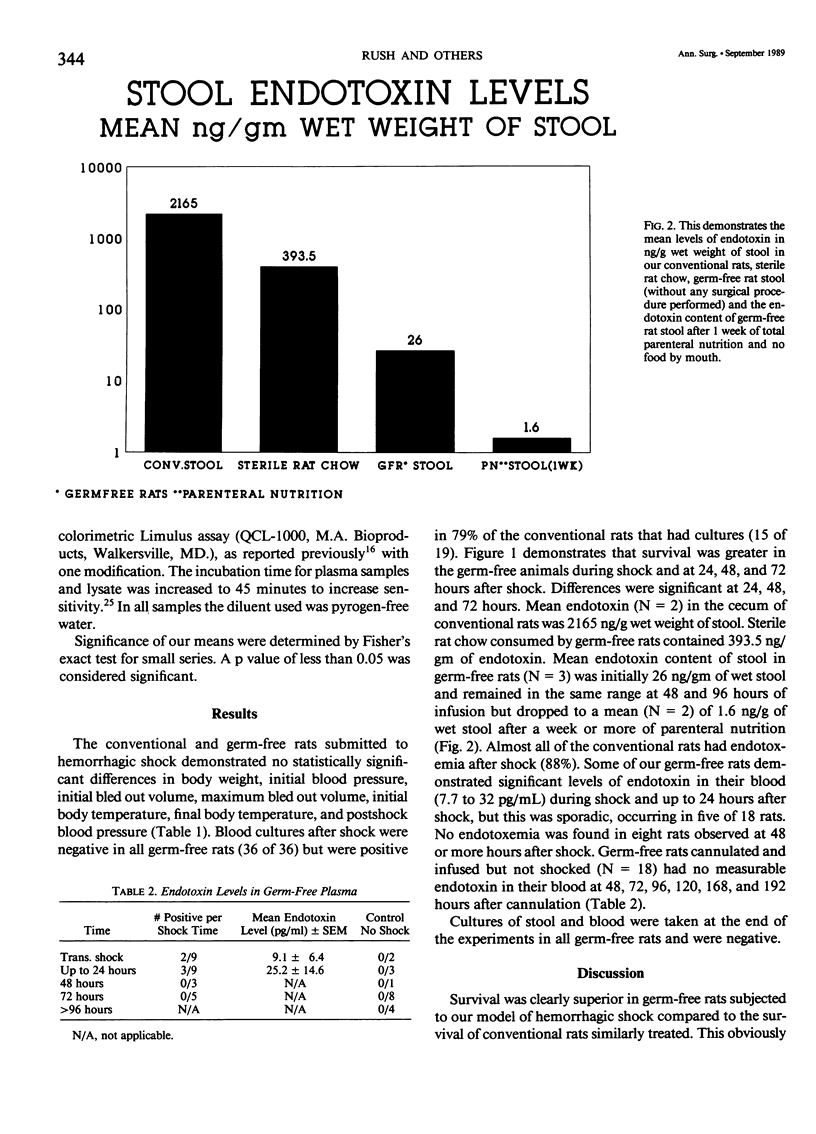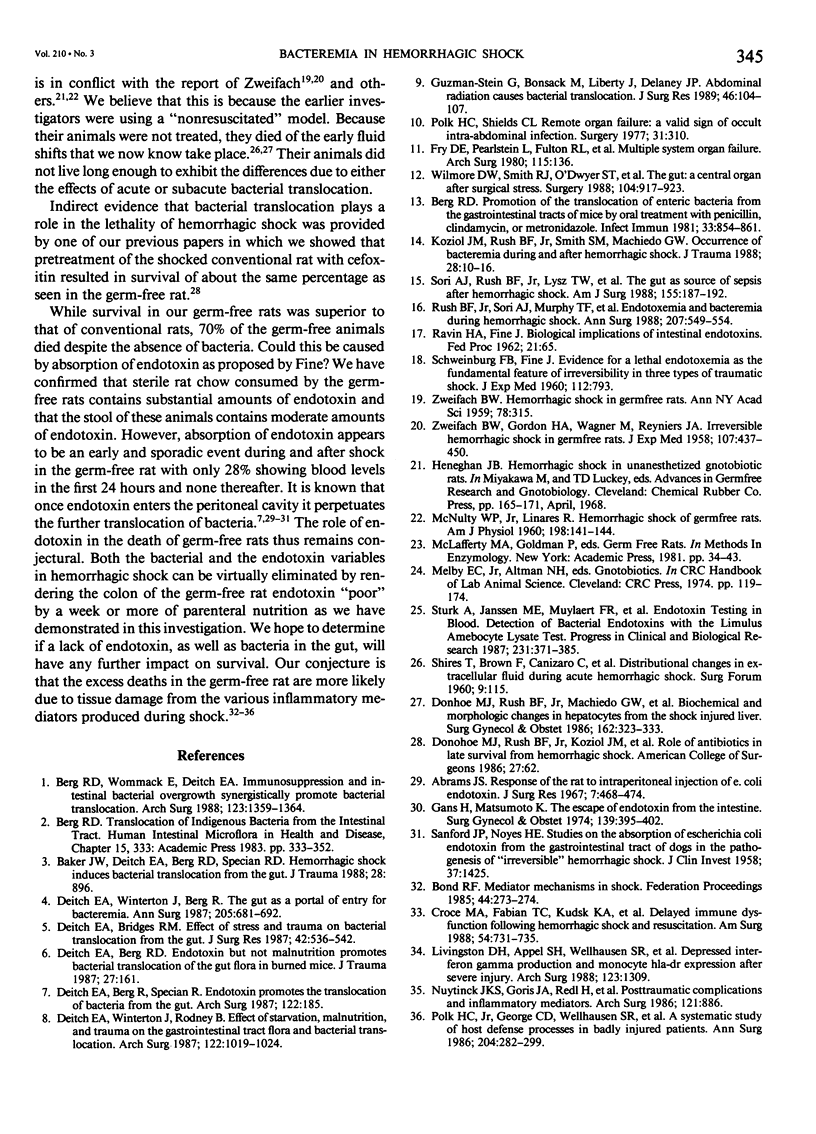Abstract
We have recently reported the rapid appearance of bacteria and endotoxin in the blood of rats and of trauma patients in the course of 30 minutes to 2 hours of hemorrhagic shock. The current study was designed to determine the effect of this bacteremia and endotoxemia on survival. Thirty-three conventional (C:group 1) and 36 germ-free (GF:group 2) Sprague Dawley rats were subjected to our previously described model of treated hemorrhagic shock. Survival in the GF group was significantly better than the C group at 24, 48, and 72 hours after shock. Endotoxin levels were elevated in 88% of C group during shock and in 28% of GF group. The gut of the GF animal contains endotoxin (26 ng/gm of stool) as does the sterile food supply (393 ng/gm of rat chow).
Full text
PDF



Selected References
These references are in PubMed. This may not be the complete list of references from this article.
- Abrams J. S. Response of the rat to intraperitoneal injection of E. coli endotoxin. J Surg Res. 1967 Oct;7(10):468–474. doi: 10.1016/0022-4804(67)90014-5. [DOI] [PubMed] [Google Scholar]
- Baker J. W., Deitch E. A., Li M., Berg R. D., Specian R. D. Hemorrhagic shock induces bacterial translocation from the gut. J Trauma. 1988 Jul;28(7):896–906. doi: 10.1097/00005373-198807000-00002. [DOI] [PubMed] [Google Scholar]
- Berg R. D. Promotion of the translocation of enteric bacteria from the gastrointestinal tracts of mice by oral treatment with penicillin, clindamycin, or metronidazole. Infect Immun. 1981 Sep;33(3):854–861. doi: 10.1128/iai.33.3.854-861.1981. [DOI] [PMC free article] [PubMed] [Google Scholar]
- Berg R. D., Wommack E., Deitch E. A. Immunosuppression and intestinal bacterial overgrowth synergistically promote bacterial translocation. Arch Surg. 1988 Nov;123(11):1359–1364. doi: 10.1001/archsurg.1988.01400350073011. [DOI] [PubMed] [Google Scholar]
- Croce M. A., Fabian T. C., Kudsk K. A., Trenthem L. L., Patterson C. R. Delayed immune dysfunction following hemorrhagic shock and resuscitation. Am Surg. 1988 Dec;54(12):731–735. [PubMed] [Google Scholar]
- Deitch E. A., Berg R. D. Endotoxin but not malnutrition promotes bacterial translocation of the gut flora in burned mice. J Trauma. 1987 Feb;27(2):161–166. doi: 10.1097/00005373-198702000-00012. [DOI] [PubMed] [Google Scholar]
- Deitch E. A., Berg R., Specian R. Endotoxin promotes the translocation of bacteria from the gut. Arch Surg. 1987 Feb;122(2):185–190. doi: 10.1001/archsurg.1987.01400140067008. [DOI] [PubMed] [Google Scholar]
- Deitch E. A., Bridges R. M. Effect of stress and trauma on bacterial translocation from the gut. J Surg Res. 1987 May;42(5):536–542. doi: 10.1016/0022-4804(87)90029-1. [DOI] [PubMed] [Google Scholar]
- Deitch E. A., Winterton J., Berg R. Effect of starvation, malnutrition, and trauma on the gastrointestinal tract flora and bacterial translocation. Arch Surg. 1987 Sep;122(9):1019–1024. doi: 10.1001/archsurg.1987.01400210057008. [DOI] [PubMed] [Google Scholar]
- Deitch E. A., Winterton J., Li M., Berg R. The gut as a portal of entry for bacteremia. Role of protein malnutrition. Ann Surg. 1987 Jun;205(6):681–692. doi: 10.1097/00000658-198706000-00010. [DOI] [PMC free article] [PubMed] [Google Scholar]
- Donohoe M. J., Rush B. F., Jr, Machiedo G. W., Barillo D. J., Murphy T. F. Biochemical and morphologic changes in hepatocytes from the shock injured liver. Surg Gynecol Obstet. 1986 Apr;162(4):323–333. [PubMed] [Google Scholar]
- Fry D. E., Pearlstein L., Fulton R. L., Polk H. C., Jr Multiple system organ failure. The role of uncontrolled infection. Arch Surg. 1980 Feb;115(2):136–140. doi: 10.1001/archsurg.1980.01380020006003. [DOI] [PubMed] [Google Scholar]
- Gans H., Matsumoto K. The escape of endotoxin from the intestine. Surg Gynecol Obstet. 1974 Sep;139(3):395–402. [PubMed] [Google Scholar]
- Guzman-Stein G., Bonsack M., Liberty J., Delaney J. P. Abdominal radiation causes bacterial translocation. J Surg Res. 1989 Feb;46(2):104–107. doi: 10.1016/0022-4804(89)90211-4. [DOI] [PubMed] [Google Scholar]
- Koziol J. M., Rush B. F., Jr, Smith S. M., Machiedo G. W. Occurrence of bacteremia during and after hemorrhagic shock. J Trauma. 1988 Jan;28(1):10–16. [PubMed] [Google Scholar]
- Livingston D. H., Appel S. H., Wellhausen S. R., Sonnenfeld G., Polk H. C., Jr Depressed interferon gamma production and monocyte HLA-DR expression after severe injury. Arch Surg. 1988 Nov;123(11):1309–1312. doi: 10.1001/archsurg.1988.01400350023002. [DOI] [PubMed] [Google Scholar]
- McLafferty M. A., Goldman P. Germfree rats. Methods Enzymol. 1981;77:34–43. doi: 10.1016/s0076-6879(81)77008-3. [DOI] [PubMed] [Google Scholar]
- Nuytinck J. K., Goris J. A., Redl H., Schlag G., van Munster P. J. Posttraumatic complications and inflammatory mediators. Arch Surg. 1986 Aug;121(8):886–890. doi: 10.1001/archsurg.1986.01400080028004. [DOI] [PubMed] [Google Scholar]
- Polk H. C., Jr, George C. D., Wellhausen S. R., Cost K., Davidson P. R., Regan M. P., Borzotta A. P. A systematic study of host defense processes in badly injured patients. Ann Surg. 1986 Sep;204(3):282–299. [PMC free article] [PubMed] [Google Scholar]
- Polk H. C., Jr, Shields C. L. Remote organ failure: a valid sign of occult intra-abdominal infection. Surgery. 1977 Mar;81(3):310–313. [PubMed] [Google Scholar]
- RAVIN H. A., FINE J. Biological implications of intestinal endotoxins. Fed Proc. 1962 Jan-Feb;21:65–68. [PubMed] [Google Scholar]
- Rush B. F., Jr, Sori A. J., Murphy T. F., Smith S., Flanagan J. J., Jr, Machiedo G. W. Endotoxemia and bacteremia during hemorrhagic shock. The link between trauma and sepsis? Ann Surg. 1988 May;207(5):549–554. doi: 10.1097/00000658-198805000-00009. [DOI] [PMC free article] [PubMed] [Google Scholar]
- SANFORD J. P., NOYES H. E. Studies on the absorption of Escherichia coli endotoxin from the gastrointestinal tract of dogs in the pathogenesis of irreversible hemorrhagic shock. J Clin Invest. 1958 Oct;37(10):1425–1435. doi: 10.1172/JCI103733. [DOI] [PMC free article] [PubMed] [Google Scholar]
- SCHWEINBURG F. B., FINE J. Evidence for a lethal endotoxemia as the fundamental feature of irreversibility in three types of traumatic shock. J Exp Med. 1960 Nov 1;112:793–800. doi: 10.1084/jem.112.5.793. [DOI] [PMC free article] [PubMed] [Google Scholar]
- Sori A. J., Rush B. F., Jr, Lysz T. W., Smith S., Machiedo G. W. The gut as source of sepsis after hemorrhagic shock. Am J Surg. 1988 Feb;155(2):187–192. doi: 10.1016/s0002-9610(88)80691-3. [DOI] [PubMed] [Google Scholar]
- Sturk A., Janssen M. E., Muylaert F. R., Joop K., Thomas L. L., ten Cate J. W. Endotoxin testing in blood. Prog Clin Biol Res. 1987;231:371–385. [PubMed] [Google Scholar]
- Wilmore D. W., Smith R. J., O'Dwyer S. T., Jacobs D. O., Ziegler T. R., Wang X. D. The gut: a central organ after surgical stress. Surgery. 1988 Nov;104(5):917–923. [PubMed] [Google Scholar]
- ZWEIFACH B. W., GORDON H. A., WAGNER M., REYNIERS J. A. Irreversible hemorrhagic shock in germfree rats. J Exp Med. 1958 Mar 1;107(3):437–450. doi: 10.1084/jem.107.3.437. [DOI] [PMC free article] [PubMed] [Google Scholar]
- ZWEIFACH B. W. Hemorrhagic shock in germfree rats. Ann N Y Acad Sci. 1959 May 8;78:315–320. doi: 10.1111/j.1749-6632.1959.tb53116.x. [DOI] [PubMed] [Google Scholar]


